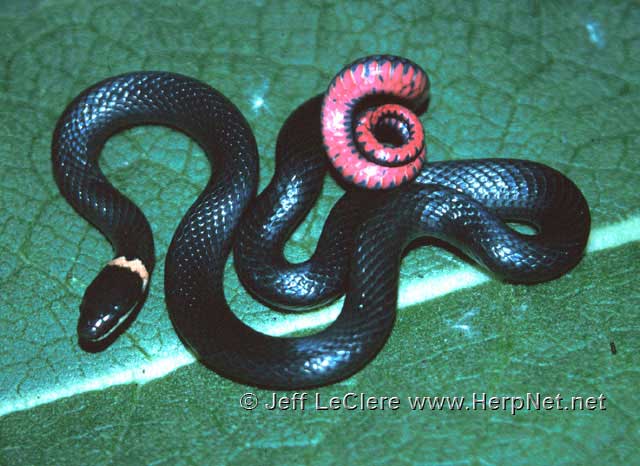Ringneck Snake (Diadophis punctatus)
Alternate names: Ring-Necked Snake
by Jeff LeClere




Status
PROTECTED and Species of Greatest Conservation Need. It is illegal to kill or collect this species by law in Iowa. Common throughout nearly all of Iowa, they are protected under state law.
Description
Harmless to humans. This is a small Iowa species that ranges from 10 – 15 inches in length (Conant and Collins, 1991). It is plain brownish, black, bluish black, or slate colored above. There are no dorsal or head markings. There is usually a yellow or orange ring around the neck, though, rarely, the ring may be incomplete. The belly is orange and has many small, black spots. The underside of the tail is bright red. The scales are smooth and the anal plate is divided.
Subspecies
Iowa has one subspecies of ringneck snake: the prairie ringneck snake, Diadophis punctatus arnyi. The prairie ringneck has an orange or yellow venter with numerous randomly scattered black spots and a bright red or orange undertail. The neck ring is usually orange or very rarely absent.
Range
The ringneck snake is locally common throughout all but parts of north central Iowa.


Habitat
Ringneck snakes are a woodland species in Iowa. The prairie ringneck snake is an abundant woodland edge species that is found in and under moist rotting logs, under rocks and debris on bluff prairies, open grasslands, or southwest facing rocky outcrops. Populations are scattered locally; they may be very abundant in one area but are absent only a mile away. A number of these snakes may be found while flipping rocks, particularly in the spring. Ringneck snakes may also be found in woodpiles and are sometimes carried inside the house with the firewood in the summer. They can be removed by simply picking them up and carrying them outside.
Habits
Ringneck snakes are active from April to October. These snakes are very secretive and spend their days hiding under debris. They are crepuscular and may be found crossing trails at dusk. They are sometimes nocturnal in hot weather, but many may estivate underground until cooler weather. They breed in the spring and sometimes the fall. The female lays four or five eggs under rotting logs or rocks in summer. The young are about four inches in length at hatching. These snakes are completely harmless to humans and rarely attempt to bite. Instead, they try to slide through one’s fingers. When alarmed, they may coil their tails into a tight spiral showing the bright red underside.
Food
Ringneck snakes eat earthworms, soft-bodied insects, salamanders, frogs, small snakes, lizards, and newborn rodents (LeClere, 1993). This is Iowa’s smallest constricting snake, though it may not commonly use this method for subduing prey. These snakes have stronger bodies when compared to other small snakes (such as those in the genus Storeria). These snakes are also rear fanged and mildly venomous. Prey preference is apparently affected by geographical location (Rossi and Rossi, 1995); some prey items refused by one subspecies are relished by another subspecies.
